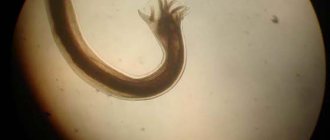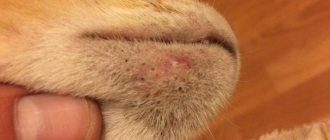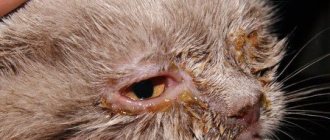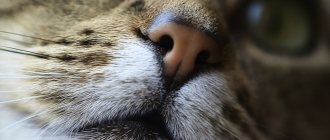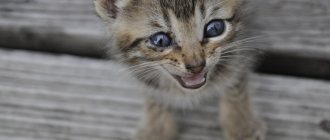In cats, the color of feces is determined by bile, which flows from the gallbladder into the lumen of the duodenum in a certain amount. This happens when the animal is healthy. Normally, cat feces are dark brown in color, and most pathologies of the gastrointestinal tract associated with the flow of bile into the small intestine can be determined by changes in their shade. White feces in a cat is an alarming sign, which should be a reason for increased attention to the health of your mustachioed pet and an incentive to consult a veterinarian.
The influence of nutrition on the color of excrement
In veterinary medicine, white feces are called acholic. Literally, this means “lack of bile” (Greek: chole - bile, a - without). But white feces do not always indicate serious health problems. This is always considered a pathology, but sometimes the condition is reversible in the shortest periods of time only with the help of nutritional correction.
White feces in a cat can be due to:
- feeding with bones (liver function is disrupted);
- states of dehydration (in addition to the color, the stool becomes dense and “free-flowing”);
- improper dosing or long-term use of medications that affect the gastrointestinal tract and liver system (antibiotics, sorbents);
- feeding excessively fatty foods (not always and not for everyone, but often);
- digestive disorders due to stress;
- too much dairy products (stool becomes light yellow, sometimes turning white, due to indigestion due to fermentation in the intestines).
Usually, after eliminating the above reasons, the color of stool returns to normal.
Reasons why stool becomes lighter
Hepatitis of various etiologies
Normally, the color of a cat's stool is brown, formed, and moderately dense. When the liver and biliary tract become inflamed, the flow of bile is disrupted, which is why the cat has white feces. Hepatitis is non-infectious when an animal comes into contact with pesticides for a long time or accidentally ingests poisonous plants. Infectious inflammation is caused by bacteria and viruses. Symptoms:
- temperature increase;
- darkening of urine;
- yellowness of the mucous membranes and eye sclera;
- increased thirst;
- diarrhea or constipation (stool is excreted in round, dense grains);
- weight loss;
- heart rhythm disturbance.
Cholecystitis
With this non-arc, the animal does not feel the desire to play with anything.
With this disease, the gallbladder becomes inflamed, which leads to stagnation and decreased flow of bile. The cause of the disease is poor-quality or expired food, abdominal injuries, irregular nutrition, metabolic disorders, severe infectious diseases, and worms. In addition to the fact that the cat’s stool becomes gray or whitish, the following signs are observed:
- jaundice;
- frequent vomiting;
- loss of appetite;
- lethargy, refusal to play;
- dry mucous membranes;
- increased need for water;
- dull, patchy fur.
Cholelithiasis
Cholelithiasis is characterized by the formation of stones in the intrahepatic and biliary tracts and bladder that block the ducts. Most often it develops against the background of liver pathologies, as well as due to metabolic disorders of cholesterol, phospholipids, bilirubin, bile acids and pigments. This promotes the formation of thick bile and cholesterol crystals in it, which later become denser, forming stones. Symptoms:
The presence of stones in the gall bladder causes the pet to lose a lot of weight.
- jaundice;
- vomit;
- dehydration;
- decreased heart rate;
- abdominal pain;
- weight loss;
- white stool;
- skin itching.
Worm infestation
If a cat poops white feces, it may be liver damage from helminths such as fluke, roundworm, toxocara, cucumber tapeworm, hookworm. Worms and their eggs clog the bile ducts, disrupting the flow of bile. Parasites enter a cat's body by eating raw fish or meat, grass, drinking contaminated water, or licking its paws after a walk. Manifestation:
- stool is white or gray;
- vomit;
- itching in the anus, the cat “rides” on its butt;
- hair loss;
- skin rashes and redness;
- deterioration of wool structure;
- liver enlargement;
- yellowness of the sclera and mucous membranes;
- abdominal pain;
- refusal of food;
- stool instability.
Cancer tumor
With such a serious illness, the animal often goes to drink water.
A cat is diagnosed with sarcoma or carcinoma, which metastasizes and has a rapid progression. The formation of a tumor in the liver and bile ducts is most often secondary, occurring against the background of a lesion in the body. In addition to the light shade, there is a bloody admixture in the stool. In the initial stages, the disease is asymptomatic, then the following symptoms appear:
- vomit;
- increased thirst;
- sudden weight loss;
- anemia due to internal bleeding;
- diarrhea;
- yellowness of mucous membranes;
- lethargy, lack of vigor;
- frequent urge to urinate.
Causes of light-colored feces in babies
If a kitten has white stool, this may indicate a lack of enzymes secreted by the pancreas. Yellow feces occur if only milk is present in the baby’s diet. In older kittens, a deviation in color may indicate dyspepsia and fermentation processes in the gastrointestinal tract.
When colorless stool is a cause for concern
Sometimes a cat's white feces can be due to more serious health reasons than poor diet. In most cases, these are deviations in the functioning of the biliary tract and the liver as a whole:
- any metabolic disorders and/or inflammatory processes in the liver (hepatosis, hepatitis);
- pancreatic enzymatic insufficiency;
- blockage or deformation of the bile ducts or gallbladder (most often due to cholelithiasis, compression of organs, torsions, adhesions);
- purulent abscess or cysts;
- cirrhosis of the liver (when there is not enough bile initially produced in the liver);
- cholangitis, cholangiohepatitis - inflammation of the bile ducts, gallbladder, or all at once;
- some renal pathologies, in which toxic products accumulate in the blood, which then affect the functioning of the liver;
- any tumor growths in the liver or biliary system that prevent the release of bile into the intestines;
- atony of the gallbladder (lack of contractions).
Light-colored stool - observation and diagnosis
White and light-colored feces in cats require a quick response, and the animal’s vital activity should be monitored.
- What kind of food does the cat have, does it ask for water.
- How much does a cat eat and drink per day?
- How many times does the cat visit the litter box, what is the nature of its bowel movements?
- Features of cat behavior during defecation.
Two or three days of observing the animal and passing the necessary tests will help the veterinarian determine the cause of the change in feces, and therefore establish the correct diagnosis and prescribe the correct treatment.
List of tests recommended by your veterinarian when your cat has white stool:
- general blood analysis;
- blood for biochemistry;
- analysis of feces and urine;
- ultrasound of internal organs;
- X-ray;
- biopsy.
Testing the animal's blood and feces will allow the specialist to assess the animal's overall health. Special laboratory tests will tell you which organ the pet has problems with. Ultrasound examination helps to identify neoplasms, displays pathological degeneration of healthy tissues, and shows stones and sand in the ducts.
What else can accompany white feces?
Any deviations in the color of feces and their consistency indicate dysfunction of the gastrointestinal tract and bile-hepatic system:
- Feces with a white coating, especially if it has a loose consistency, may indicate an excess of stringy meat products and bones in the diet.
- White feces with a liquid consistency are usually observed with liver pathologies, pancreatic enzyme deficiency, and irritable bowel syndrome.
- White-cloudy mucus indicates diseases of the large intestine. Also, such a symptom can be observed when infected with helminths - in such cases, white worms can be found in the feces.
- If white grains are found in the stool, the cat should be checked for worms, fungi of the genus Candida in the digestive tract, and the stool should be tested for digestion. White spots in the stool may be undigested food debris. Sometimes white spots can develop into small white worms - a clear sign of helminthic infestation.
What to do if the stool is white?
Therapy is prescribed by a veterinarian, depending on the etiology of the disease; self-medication is prohibited. If a large stone is observed in cholelithiasis, surgery or crushing and removal of the crystals with a laser is performed. When a tumor is diagnosed, surgery should be performed. For hepatitis, hepatoprotectors and antispasmodics are prescribed. You can expel the cat parasite with anthelmintic drugs. If there are a lot of worms, surgical removal is required. Diuretics and choleretic drugs are also used. A diet is prescribed in the form of lean broth, oatmeal with water and vitamin and mineral complexes. Among the feeds, it is recommended to choose holistic or premium brands with the Sensitive mark.
Sources:
https://koshkamurka.ru/5517-u-kota-belyj-kal.html https://vashipitomcy.ru/publ/zdorove/bolezni/belyj_kal_u_koshki_prichiny_i_diagnosticheskie_issledovanija_vozmozhnykh_zabolevanij/15-1-0-2110 https://infokotiki.ru/ zabolevania/zhkt/belyy-kal-u-koshki.html
What should a cat owner do first?
White feces in a cat - what to do? Doing anything on your own in terms of medication intervention is highly not recommended. You only need:
- over the past few days, analyze what and how Murka was fed;
- adjust feeding if nutritional disturbances are detected;
- monitor over the next few days whether there is a change in the color of the stool towards darkening;
- if a change in feeding does not lead to the restoration of the color of the stool, you should visit a veterinarian, preparing as detailed an anamnesis as possible (information about the keeping and feeding of the animal, prior to the lightening of the stool);
- If white worms are found in a cat’s feces, the feces should be submitted for parasitic analysis.
If stool lightening is simultaneously accompanied by refusal to eat, general weakness, apathy or, conversely, anxiety, diarrhea or constipation, as well as changes in body temperature (in any direction), then a visit to the veterinary clinic cannot be postponed!
Treatment by a veterinarian
Cat owners should immediately realize that it is not white feces, as such, that are being treated, but the cause that led to this condition is being eliminated. The speed of restoration of the color of feces will depend on the severity of the condition and the general condition of the cat’s body at the time of contacting the veterinary clinic. Sometimes it is possible to restore the color of stool within a few days, sometimes treatment will take longer. There are rare cases when the condition may be irreversible (liver block, oncology).
A correct diagnosis can be made based on:
- clinical examination;
- blood tests (biochemistry and general);
- urine and feces examinations;
- Ultrasound;
- x-ray;
- biopsy (usually taken from the liver, but performed quite rarely).
What treatment is used (schedules and course durations are developed only by veterinarians with individual dosage selection):
- hepatoprotectors that normalize liver functions and metabolic processes (thiotriazolin, Essentiale, Hepatovet, Hepatoject);
- choleretic drugs (ursosan, allohol, cholenzyme);
- relieving spasms and biliary-hepatic colic (buscopan, baralgin, papaverine, mebeverine).
What do worm eggs look like?
Let's say you find something that looks like worms in your pet's stool, what should you do next? First, you need to understand what you see. Fecal matter may contain live and dead parasites, their eggs, incompletely digested food, and inedible objects that the cat swallowed accidentally or intentionally.
The range of parasites that a cat can become infected with amounts to hundreds of species. Each parasite belongs to a specific family, subfamily or species. Each type of worm has similar features: color, length, body shape, shape and color of eggs. First, let's figure out what worm eggs look like, which you can distinguish visually.
White round spots in stool - what is it?
Almost all worms that parasitize the body of cats are very modest in size and have microscopic eggs that are invisible to the human eye. The exception is tapeworms, which are also called tapeworms and tapeworms.
The body of these parasites consists of:
- Heads with oral apparatus, several rows of hooks and/or suckers.
- Segments (segments) that form a long body.
- This is incredible! Depending on the type of worm, its body can consist of 4–200 segments. Each segment is a vessel for 1–800 eggs, which must be released into the external environment.
The most common tapeworm that affects cats is the cucumber tapeworm (often called borage). Parasite eggs can be identified by visual signs:
- Round with slightly pointed tips, similar to sesame or cucumber seeds.
- White, slightly transparent.
- The main distinguishing feature is that the eggs move and move due to the flat muscles of the segment.
What to do if your cat has white worms in his stool?
› Veterinary
Science has proven that 30 different types of helminths can parasitize a cat’s body. Some individuals spend their entire lives inside the animal, while others are forced to leave the body to complete their development process. Usually, with a small number of parasites, the pet does not experience discomfort; problems appear when they migrate or actively reproduce.
Let's find out what types of worms can be found in a cat's feces and how to properly carry out deworming.
What types of white worms can be found in a cat’s feces?
While cleaning a cat's litter box, owners sometimes find white worms (living or motionless) in their feces. These are worms. They are flat (cestodes) and round (nematodes). It is quite easy to distinguish them from each other.
Cestodes (found in stool) look like cucumber seeds or grains of rice and only move for a few minutes. But nematodes look like spaghetti and are able to move for quite a long time.
Cestodes (white flat worms)
Cestodes or flatworms are a large group of parasites that are found in different animals. In cats, the most common are Dipylidia, Alveococcus, Diphyllobothria and Echinococcus. In feces, two types of worms can most often be found, which cause Diphyllobothriasis and Dipilidiosis.
They look like small (5-10 mm) white oblong inclusions that move along the surface of the feces. People mistakenly believe that these are adult worms, and if they have left the intestines, then nothing needs to be done to the cat. This is the main mistake.
The appearance of white worms in a cat’s feces means that a parasite up to 70 cm long has settled in the animal’s intestines.
It has reached puberty, actively reproduces and secretes lower segments with fertilized eggs (in parasitology they are called “segments”). Moreover, he does not need a second individual, these worms are bisexual.
Hermaphroditism (the simultaneous presence of male and female reproductive organs) is a distinctive feature of cestodes.
You can find white flat worms in a cat not only in the feces, but also around the anus, stuck to the fur, or when segments accidentally fall out of the animal’s anus.
Important! Worms that are in the cat’s body secrete special proteins that reduce the activity of the enzyme (trypsin) in the cat’s digestive juices. This way the helminths are protected from digestion and can live from several months to 1 year.
Types of white worms (Dipylidium, Echinococcus, Alveococcus, Diphyllobothrium) in cats
- Dipylidium, or cucumber tapeworm, enters the cat's intestines when an infected flea is accidentally ingested. When an insect is digested, a worm larva emerges, which attaches to the wall of the stomach and actively grows.
She absorbs nutrients from food throughout her body. After the helminth reaches maturity, the process of formation of cocoons with eggs begins, which are located in the lower parts of the worm’s body. Then the white filled segments bud off and come out with feces.Next, the eggs are eaten by flea larvae and the process is repeated.
The disease in cats caused by the cucumber tapeworm is called dipylidia.
There is a danger to humans only if an infectious flea is swallowed (in adults this is practically impossible, but in small children with close contact the risk of contracting dipylidia is much higher).
- Diphyllobothrium is a parasitic worm that is acquired by cats when they eat raw fish. During the digestion process, a white worm larva emerges from the fish and attaches to the wall of the animal’s small intestine. She lives there for 3-4 weeks and grows up to 1.5 m. During the period of its life, the long helminth secretes cocoons of eggs, which are released with the cat’s feces. After a month, the parasite completely leaves the body during vomiting or defecation.
Diphyllobothrium is also dangerous to humans and other carnivores. Their worm grows up to 10 meters with a lifespan of up to several years.
- Alveococcus is a small parasite, infection occurs by eating infected rodents. The worm larva penetrates the small intestine of the cat and grows for 3 months, reaching up to 5 mm in length, then forms segments with eggs, which break off as they mature and come out with the animal’s feces. In the environment, alveococcal eggs are preserved due to the formation of fine bubble foam, which attracts rodents. If a person accidentally eats grass with invasive foam, then tumor-like infiltrates (a vesicle with the head of a worm) are formed in the liver with the possibility of metastasis to the brain, lungs, and other organs. Infection leads to various disorders in the body, including death.
- Echinococcus is a small white worm, the size of which in the mature state does not exceed . A cat can become infected in two ways: by eating an invasive rodent (with an egg hatching into a worm larva inside) or by ingesting worm eggs from the grass. Depending on this, there are two options for the development of the disease. In the case of eating a rodent, the mechanism will be similar to alveococcosis. If a cat swallows Echinococcus eggs from the grass, then bubbles with worm heads will form in the internal organs of the animal, which will remain underdeveloped, but will bring a lot of painful sensations to the pet. In humans, infection proceeds similarly.
Appearance of worms in cat feces
All feline cestodes are united by external similarity in body structure. These are long, segmented white helminths with suckers that differ only in size.
What do segments of white flatworms look like in a cat’s feces:
Name of the parasiteSize of an adult wormSize of a segment with eggsAppearance of a segment with eggsVisualization of worms in feces
| Dipylidium | 30-70 cm | 1-1.5 cm | Oval (like a grain of rice) | Naked eye |
| Diphyllobothrium | 100-150 cm | 1-1.5 cm | Short, rectangular | Naked eye |
| Alveococcus sexually mature | 0.5 cm | less than 1 mm | Oval | Under a microscope |
| Echinococcus sexually mature | 0.5-0.7 cm | less than 1 mm | Oval | Under a microscope |
A distinctive feature of feline cestodes is the short time period of motor activity of individual segments that were found in the feces.
Usually, after a few minutes, the energy reserve of the white segment runs out and it stops moving. However, the parasite eggs inside remain viable for a long time.
Symptoms of the disease
External clinical manifestations of cestodiasis in the early stages are usually absent. As the worms grow and develop, they release toxic substances that are absorbed into the cat’s blood and lead to increasing intoxication of the body.
Vomiting appears, uneven stools with an admixture of white worms in the feces, taste perversions, the feeling of hunger increases, and the body is depleted. Sometimes toxins affect the cat's nervous system, leading to seizures.
Treatment and prevention
To successfully cure worms, it is necessary to deworm the cat with veterinary drugs based on praziquantel. This active substance is included in the preparations:
- "Milprazon" (meat tablets for kittens and cats);
- "Milbemax" (chewable tablets for large and small cats);
- "Kanikvantel" (1 tablet with meat flavor, designed for 10 kg);
- “Cestal cat” (liver-flavored tablet – 4 kg);
- "Drontal cat" (4 kg tablet);
- “Profender” (drops on the withers);
- “Dironet (tablets, suspension and drops on the withers);
- "Prasitel" (tablets);
- "Fenpraz" (tablets with royal jelly).
For intestinal cestodias, a double dose of the drug with an interval of 10-14 days is usually sufficient. For greater effectiveness, medications are given in the morning, before feeding the cat.
After the animal recovers, the course of anthelmintic therapy will need to be repeated every 3 months to prevent re-infestation.
Important! If an animal has been diagnosed with cystic echinococcosis (bubbles in the internal organs), then the doctor prescribes complex treatment with special drugs.
Also, the possibility of surgical intervention cannot be ruled out, since cysts are constantly growing, putting pressure on surrounding tissues and impairing blood circulation.
In addition, the bubble with parasites may burst, the fluid will spread in the cat’s body, which will further aggravate its condition.
Nematodes (white roundworms) (Toxocara, hookworm, uncinarium)
Roundworms (nematodes) also infect the gastrointestinal tract of cats, and their favorite location is the small intestine. Unlike white tapeworms, round worms reproduce and live inside the cat for several generations.
They can fill the entire intestine, even to the point of developing obstruction. Nematodes do not always leave the cat's gastrointestinal tract along with feces. They secrete eggs, the presence of which can be easily determined in the laboratory.
If your cat's stool contains thread-like white worms that look like spaghetti and squirm and make circular movements, then these are most likely nematodes. The intestines are clogged with parasites, they become crowded, some of the individuals pass out along with the feces. There are also frequent cases of nematodes coming out with vomit.
Types of parasites
- Toxocaras are thin, long white worms (6-10 cm) with a sharp end. It most often affects kittens aged 1-3 months who eat invasive raw meat, rodents, flies, or become infected in utero. After digesting the food eaten, Toxocara larvae emerge from the eggs and move into the kitten’s lungs.
After some time, the grown worm larvae irritate the walls of the lung, cough up and are swallowed again. Worms actively multiply in the small intestine of a kitten. When the intestines empty, the eggs come out and settle on the grass, where they are eaten by mice, livestock or insects. Toxocariasis is dangerous for both cats and humans.Worm eggs can be found on furniture, children's toys, and can also be carried by flies. When eggs are ingested in the body of a child or adult, the larva does not develop into an adult, but migrates to other organs and becomes encapsulated, which causes a number of ailments.
- Hookworms are smaller worms 2-3 cm long.
They feed on the blood of kittens and cats and can cause anemia and death of young animals. The location of hookworm is the small intestine. Kittens become infected with worm eggs through contact with sick animals, food and water. The larvae grow, injure the intestinal mucosa and cause swelling.When actively multiplying, hookworms can lead to complete blockage and obstruction of the intestine. Due to the massive accumulation, some of the worms die, which often leads to intoxication with decay products. Against the background of existing anemia, this process ends in the death of the kitten.
- Uncinaria are small white nematodes 1-1.5 cm in size.
They cut through the mucous membrane of the small intestine and feed on blood. The life cycle is similar to hookworms. Life expectancy in a cat’s body is up to 2 years.
What do worms look like in cats?
Roundworms in cats are white with a yellowish tint. Visually, they are similar to thin fishing line or spaghetti pasta. They have a hard shell. The length of adult individuals ranges from 1 to 10 cm. The body is not segmented.
Signs of the disease
Common signs of increasing roundworm infestation include:
- poor appetite;
- a swollen, dense and painful abdomen in kittens (due to food refusal);
- weight loss;
- anemia, which is manifested by pallor of the mucous membranes;
- liquid cat feces (sometimes mixed with blood or white worms);
- vomiting of live helminths (with blockage);
- hyperthermia;
- dull, tousled fur.
- cough (during Toxocara migration).
Important! In severe stages of infestation, the intestinal walls may rupture and worms may escape into the abdominal cavity, which leads to internal bleeding and death of the cat.
